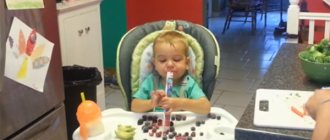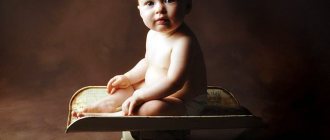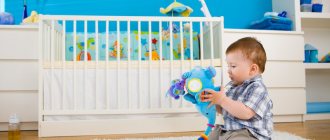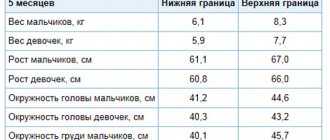How do children lose their baby teeth?
Most often, the loss of baby teeth begins in a child at the age of six. But some children may lose their first baby tooth at age 7. This is due to the fact that the process of loss of baby teeth and growth of molars is individual for each child, as it is associated with hereditary predisposition. That is, if one of the baby’s parents began changing teeth in childhood earlier or later than 6 years old, then there is a high probability that their child’s baby teeth will begin to fall out in the same period.
The baby “loses” his baby teeth because the molars, starting to grow, destroy their roots. This causes the baby tooth to become loose and fall out. Baby teeth in 6-year-old children fall out in the same order in which they grew. The lower central incisors fall out first, followed by the upper central incisors.
When a baby tooth falls out, a small wound forms in its place, which can bleed for 5-10 minutes. To prevent the baby from swallowing blood, you need to make a sterile gauze or cotton swab and let the baby bite on it for about 15 minutes. If bleeding from the wound at the site of a fallen baby tooth lasts longer than the specified time, then you need to show the child to a pediatrician and/or a pediatric dentist. Perhaps the doctor will order the baby to take a blood test for clotting and prescribe medications based on the test results.
Why are baby teeth needed, their difference from permanent teeth
Temporary teeth - canines, molars, lateral and central incisors, which are replaced by molars. Their appearance is a painful process, which is accompanied by a decrease in immunity. But they are also important for the baby. The purpose of temporary incisors, canines and molars is to:
- ability to chew food;
- proper speech development;
- formation of the facial skeleton and bite;
- acquiring chewing skills;
- aesthetics of the oral cavity.
The main difference from permanent ones is their ability to quickly break down. If an adult loses a tooth, he will experience pain in its place for a long time. When baby incisors begin to change, this does not happen: during the period of loss, they become loose, and therefore children do not notice their loss. Parents have the incorrect opinion that incisors do not have nerves or roots. This myth is based on the fact that temporary teeth fall out painlessly. However, from a dental point of view, these two facts are in no way related to each other.
Although temporary incisors fall out, they need to be cared for after the first one appears. You should not think that they do not need cleaning and care, since they are not permanent anyway. The condition of the temporary incisors will also determine the condition of the molars. If dental diseases appear, you should consult a doctor, as they provoke an incorrect bite or jaw structure.
If you look at the outside of a child’s mouth, you will notice that permanent teeth are not much different from temporary teeth. But there is a difference. Primary canines, molars and incisors have the following features:
- thin enamel;
- the crown is smaller;
- the pulp is larger;
- milky shade;
- they are susceptible to caries;
- located vertically;
- divergence of roots due to molars;
- wide channels.
The number of baby teeth in children is also excellent: there are only 20 of them, and 32 permanent ones. They make up the chewing row.
How do 6 year old children cut teeth?
We have already discussed how the process of baby tooth loss occurs, now we will look at how teeth grow in 6-year-old children. Most parents believe that the growth of a child's molars begins after the first baby tooth falls out, but this is not so. Even before your baby's baby teeth begin to loosen, his first molars, called first molars, are erupting. These are two pairs of chewing teeth that appear in the free space of the child’s upper and lower jaw.
Now let's look at how children cut teeth if they grow in place of baby teeth. It takes 3-4 months between the loss of a baby tooth and the appearance of a molar in its place. All this time, the permanent tooth grows inside the gum. When the molar “approaches” the gum, it begins to turn red, as the blood flow to it increases, and swells a little, then the process of tooth eruption occurs. Sometimes it happens that a molar does not appear in the vacant gum space for six months, and the child’s parents naturally begin to worry about this. Usually, such long-term growth of a tooth in a child’s gum is an individual characteristic of the baby, but in order to make sure that everything is in order with the teeth, it is necessary to take the child to an appointment with the dentist and have an orthopantomogram (X-ray of all teeth in the lower and upper jaw). A survey x-ray will show how teeth are cutting in 6-year-old children, since it shows those teeth that have already erupted and those that are still in the gums.
In some cases, milk teeth do not allow molars to erupt: the permanent tooth is already ready to appear, but the milk tooth “does not want to fall out.” This can lead to the development of an inflammatory process in the child’s oral cavity, the appearance of painful sensations, and naturally, because of this, the baby will become capricious and his sleep will be disturbed. Therefore, in such situations, the child must be immediately taken to see a pediatric dentist. The doctor, under local or general anesthesia, will remove the baby’s baby tooth and may prescribe an antiseptic mouth rinse to stop the inflammatory process.
Teeth of 4 year old children. The importance of caring for baby teeth
How many teeth should a child have at 4 years old? By the age of 4, almost all children have a full set of baby teeth - 20 pieces (maybe only 16 - this is individual, and this is the norm). The child actively uses them - bites, chews. That is, teeth are constantly in an aggressive environment and are subject to mechanical stress, including abrasion. In the article “Baby teeth in children - norm, features, purpose,” we talked in detail about the structure of children’s teeth.
In particular, the fact that the enamel coating of baby teeth is much thinner than that of permanent teeth, that it is more permeable, and the pulp occupies most of the volume of the tooth. For this reason, the first teeth are more susceptible to caries, and carious cavities reach the pulp faster. In an adult, before the onset of inflammation of the pulp - pulpitis, caries develops for a year, or even several years. Six months or a little more is enough for children's teeth. Especially if the child does not receive adequate nutrition or has a metabolic disorder. This is where caring for baby teeth comes to the fore.
Treatment and care of baby teeth
Many parents have a big misconception - baby teeth are temporary, which means it is not necessary to take care of them, there is no need to treat them, they say, they will fall out anyway. This is fundamentally wrong - a baby’s teeth are vitally important, and that’s exactly what they are at this time. This is how a child’s body works. And the absence or inadequate functioning of baby teeth can lead to irreparable losses in later life. Untreated baby teeth can lead to both local problems, the most difficult of which is damage or even dissolution of the permanent tooth germ, and general problems: diseases of the gastrointestinal tract, problems with the adenoids, chronic runny nose and tonsillitis, etc. Treatment Primary teeth treatment in children is no less important than the treatment of permanent teeth. Untimely removal of a baby tooth leads to the shifting of other teeth, which means abnormal development of the jaw. The location of the rudiments of permanent teeth automatically shifts, which will grow very closely in one place, and in others there will be large, unaesthetic gaps.
The earlier the baby loses a baby tooth, the more noticeable the consequences will be. For example, if a child soon loses chewing teeth (before 5-6 years), then the correct growth of the jaws is disrupted, and even facial features change, especially in the lower part. If caries of baby teeth has begun, timely treatment is the most important factor in the full development of permanent teeth (“What is the danger of premature removal of baby teeth”). Sucking on a pacifier, feeding from a bottle, and even breastfeeding after the age of 2 years also have a very unfavorable effect on baby teeth. It is for this reason that we constantly draw the attention of adults - take care of your children’s early teeth, because this is their ticket to a healthy, fulfilling life.
How many teeth do 6 year old children have?
At this age, the number of teeth in a child can vary from 20 to 24. Let's look at why this is so. By the sixth year of life, the baby has 20 milk teeth in his mouth, which “settled” there when the child was 2.5-3 years old. At the age of six, a child’s first pair of permanent chewing teeth begins to erupt in the lower jaw, and then a pair of upper ones. In total, the baby has 24 teeth in his mouth: 20 of them are milk teeth and 4 are molars. Then the process of baby teeth falling out begins, and, as a result, the child’s teeth become smaller. At the age of six, a baby usually “loses” 4 teeth: a pair of upper and lower central incisors. That is, a child can again have 20 teeth. Also, at the age of 6, children erupt a pair of molar lower central incisors, and as a result, the baby’s mouth has 22 teeth: 16 of them are milk teeth and 6 molars. There are cases that a child at this age erupts a pair of molar upper central incisors, and then the child at 6 years old has 24 teeth.
The above calculations of how many teeth six-year-old children have are relative, since it has already been said that each child’s teeth fall out and erupt according to an individual schedule. But, based on the generally accepted timing of the appearance of permanent teeth and the loss of milk teeth, the following mathematical calculations can be made.
I hope that in this article, parents found all the answers to questions about baby and molar teeth in 6-year-old children. I would like to draw the attention of mothers and fathers that at this age it is imperative to take the child for a consultation with a pediatric dentist, even if the baby has no complaints. The doctor will examine the child’s oral cavity, assess the condition of the teeth, and give parents recommendations on how to care for the baby’s teeth during this period.
How many teeth should there be?
There are primary (temporary) teeth that erupt at the age of 6 months. up to 2.5 years, and permanent ones, which appear between the ages of 6 and 14 years. The exception is wisdom teeth (third molars), which erupt later.
Humans have 20 primary teeth: 8 incisors, 4 canines and 8 molars; There are 32 permanent teeth, of which 12 are large molars. The development of primary and permanent teeth begins on the 40–45th day of intrauterine life and continues until the 5th year of life. The order in which teeth are laid down also determines the order in which they erupt. Those teeth, the formation of which occurs in the first period (up to 5 months) of intrauterine life, erupt first. These are baby, or temporary, teeth. Teeth formed from the 5th month of intrauterine life to the 5th year of a child’s life erupt secondarily and are permanent.
How are permanent teeth different from baby teeth?
After a change in bite, the rules of oral care also change, since permanent and temporary teeth are very different from each other:
- The indigenous ones are denser and have a high degree of mineralization.
- Baby teeth are much whiter than permanent teeth. The enamel of molars, canines or molars is naturally light yellow.
- The pulp (bundle of nerve endings) in permanent teeth is more developed, which is why the walls of the hard tissue are much thinner.
- In a young child, the dentofacial apparatus has a less developed root system; after a change in bite, it becomes stronger.
- Even the appearance of baby teeth is smaller. Babies' jaws are not yet fully developed, so a standard row simply wouldn't fit.
- There are more permanent teeth. In adolescence, sixes begin to form, which young children do not have.
At what age do molars begin to emerge in children?
Usually the first molars appear in children aged 5–6 years , but sometimes the primary lower incisors fall out in four-year-old children or even in children younger. In pediatric dentistry, they usually do not indicate the exact timing of changing the dentition, since each child is individual. For some, the primary incisors begin to fall out immediately after the complete formation of the temporary bite; for others, even in grades 2–3, they still do not have a single permanent tooth.
The last temporary molars are replaced at the age of 12–13 years. The period when children start teething six begins only after 14 years. These premolars no longer have milk predecessors.
There is another group of teeth that comes out later than the others. They are popularly known as wisdom teeth; dentists prefer to call them figure eights. They grow up at 18 years of age and later. There are cases where third molars begin to appear only after 30 years. This phenomenon cannot be called a pathology, just like cases when the figure eights do not cut through at all.
The order and timing of the eruption of molars: table and diagram
First, the child’s teeth change according to the same pattern in which they are cut in newborns. Only at 14–15 years will additional molars grow, which were not there during the temporary dentition.
The table below shows the timing of the eruption of permanent teeth in children. You should not rely exactly on the indicated age; the period of mixed dentition may pass much faster or be prolonged.
| Dental kit | Age |
| Lower central incisors | 5–6 years |
| Upper central incisors | 5–6 years |
| Lower lateral incisors | 8–9 years |
| Upper lateral incisors | 8–9 years |
| Upper first molars (premolars) | 9–12 years |
| Lower first molars (premolars) | 9–12 years |
| Fangs | 12–13 years old |
| Mandibular second molars | 14–15 years old |
| Maxillary second molars | 14–15 years old |
The age at which children's teeth begin to grow may be different, but the order in which permanent teeth erupt is almost always the same as in the table. Only in rare cases does everything happen in a different sequence.
Scheme of eruption of permanent teeth in children:
When baby teeth fall out
Loss of baby teeth is a natural process that is typical for all children over 5-6 years of age. In place of the fallen ones, permanent ones grow in; they are stronger and less vulnerable to external irritants.
The pulp of permanent teeth is located in their central part; it is much smaller in size, which prevents caries from causing inflammatory processes and the development of pulpitis so quickly.
The order in which baby teeth fall out coincides with the order in which they erupt. Usually, up to 6 years of age, the central incisors are the first to go, followed by the lateral incisors (at about 7-8 years of age). This process occurs painlessly. If any problems arise, it is better to consult a dentist to avoid aggravation of the condition.
The loss of the milk unit is immediately preceded by the process of self-destruction of its root. It dissolves in the gum, the tooth begins to wobble and, after the nerve endings and tissues of the oral cavity are separated from it, it falls out.
Complete replacement of baby teeth with permanent teeth is completed before the age of 12.
Symptoms of eruption of molars
If you have the following signs, you should prepare for a bite change:
- Gaps appear and increase between the teeth, as in the photo. This indicates that the jawbone is growing and will soon have enough space for permanent molars and incisors.
- Baby teeth become less stable and gradually loosen. This happens because the process of growth of molars has already begun under the child’s temporary teeth.
- Of course, the loss of a baby tooth is a sure sign that a permanent one will begin to grow very soon. Exceptions are disturbances in the order of growth and injury to children's teeth.
- Even if the tooth has not yet fallen out or is loose, swelling and redness may form around it. If you do not take care of hygiene during the period of change of bite, it can end in the formation of a fistula or cyst.
- The child develops a runny nose, and the nasal discharge is liquid and clear.
- Salivation increases sharply, and you have to constantly use a handkerchief.
- Poor sleep, tearfulness and general malaise are also common symptoms.
- When teeth erupt, various digestive problems also arise. Due to toothache, nutrition is disrupted, which leads to such symptoms.
Temperature during molar teething in children
Often the appearance of molars in children is accompanied by fever, but it should not rise above 38 ° C and last longer than four days. If the fever lasts longer than several days, is accompanied by a runny nose (profuse and opaque), dry and frequent cough, you need to show the baby to a pediatrician. Such symptoms indicate an infectious disease of the upper respiratory tract, which often develops during teething due to the increasing vulnerability of the body.
How to relieve unpleasant symptoms when teething
Toothache is an extremely unpleasant symptom even for an adult, not to mention children. Teething is accompanied not only by discomfort, but also by general malaise, so it is better to find out in advance at what age children’s molars come in and prepare for this period.
When teething, the gingival mucosa is damaged and aseptic (i.e., “germ-free”) inflammation occurs, which causes fever, diarrhea, sleep disturbances and the baby’s appetite. At the same time, as a result of damage, the gums become more vulnerable to infection and the occurrence of septic (i.e., “microbial”) inflammation, which can complicate the already difficult period of teething. Conventional drugs for the treatment of inflammation of the oral mucosa are not always convenient for use in young children. You should choose a drug intended for use in children. For example, Cholisal® has proven itself well. When applied topically, it has a triple effect, helping to relieve pain and inflammation and also acting on viruses, fungi and bacteria. The gel adhesive base helps to retain the active substances on the mucous membrane, prolonging their action¹. It is important to exercise caution when using in children under one year of age and consult a doctor first.
1. Instructions for use of the medicinal product for medical use Cholisal®. There are contraindications. You need to read the instructions or consult a specialist.
How to relieve symptoms:
- If a baby tooth has already fallen out and the gums are very itchy, gently massage it with your finger. Just wash and disinfect your hands thoroughly first. You can use special brushes for massage.
- Cold compresses will also help, but you should not resort to them too often or for long. Several procedures per day will be enough.
- Pain-relieving gels such as Cholisal, Metrogyl Denta, Kamistad, Kalgel will also help. You need to use them carefully - no more than 4 times a day.
- To relieve fever, use standard means that you usually use. Just keep track of how many medications the child was given over the entire period, and do not exceed the norm.
- If the temperature does not subside for 2-3 days, consult a doctor.
What problems may arise during the period of teeth change?
Many problems can arise when children lose their molars. The most common complications include:
- Lack of permanent teeth.
- Growth of a permanent tooth before the loss of a temporary one.
- Pain in a molar tooth.
- Molar tooth loss.
For every case, dentists have a solution; you just need to detect the problem in time and seek help. The last two phenomena arise due to low mineralization of hard tissue, and such anomalies appear regardless of how old the molars are.
New teeth are always very vulnerable in the first few weeks after formation. If you pay little attention to oral care, caries will quickly form on permanent incisors, canines and premolars. Physical impact on hard tissues during this period also leads to a lot of consequences.
Why does the molar not grow for a long time after a baby tooth falls out?
As soon as a child’s primary incisor, canine or molar falls out, it is usually possible to feel the molar on the gum. Even if this is not the case, it should appear within a week. If there is no seal, it means that the baby tooth fell out too early. Many children loosen their teeth, and sometimes parents themselves take part in pulling them out.
In the worst case, such a symptom may indicate adentia. This pathology is extremely rare; it is caused by a serious violation of mineralization even in fetal age. Sometimes the disease appears during life due to infectious diseases. The problem is easily solved by prosthetics.
Another cause of the disorder may be a physiological delay in tissue growth. With this pathology, the eruption of all permanent teeth ends much later than usual. If the dentist finds such a defect, he will recommend making a removable denture. If you do not take advice, the permanent incisors and canines will grow crooked.
What are the dangers of growing molars before baby teeth fall out?
Typically, the growth of a molar tooth leads to the loosening of a primary tooth, but there are exceptions. It is possible to understand that the bite is changing incorrectly if all the signs of teething that were mentioned earlier are present, not accompanied by loosening of the primary incisors or canines.
This problem when a permanent tooth grows can lead to a number of problems:
- The incisor or fang begins to look for another path to cut through. In this case, children’s molars grow as in the photo on the right. Molars and premolars usually still come out of the gums, bending the entire dentition.
- The incisor or canine itself may become severely curved. It begins to bend in different directions, even before complete germination.
- Redness, itching and pain become more noticeable. Because of this, bacteria very often enter the damaged area. An infection may begin that will develop into a cyst or fistula.
- If your child's molars appear while the baby teeth are still in place, contact your dentist. He will be able to immediately detect the problem and remove the “milk jug” that is preventing the growth of the permanent tooth.
How many baby teeth should a 1 year old child have?
For a baby, teething is a very important stage in life. This is not the most pleasant process, because teething is often accompanied by redness, itching, swelling, and copious amounts of saliva. This process can be facilitated by giving the child cooled, soft, special “teethers.” You can also, on the recommendation of your pediatrician, purchase a special gel with an anesthetic or make lotions to the gums based on medicinal herbs.
For dental care you will need:
- baby pastes with a mild aroma,
- damp cotton swab,
- sterile gauze,
- silicone brush attachment.
Very often, responsible mothers wonder how many teeth a child should have at the age of 1 and try to understand whether their child is falling behind the norm. We will enlighten you on this matter.
What affects teething
The timing and speed of teething is influenced by many factors. In children who were born to mothers who suffered from toxicosis during pregnancy, had a Rh conflict with the fetus, suffered from heart defects, suffered from herpes or toxoplasmol, the delay in the eruption of baby teeth can be almost doubled.
Children's first teeth: what to do
The same picture is observed if children at birth had an intracranial birth injury, if the baby was born prematurely or was exposed to some kind of infectious disease immediately after birth.
How the dental system is formed largely depends on how the child develops in his first year of life. For example, the timing of the eruption of baby teeth and how many of them there will be may be delayed if the newborn has suffered from congenital hypothyroidism. Also, in children who have had rickets, have pathologies of the pituitary gland, have had pneumonia, and often suffer from acute respiratory viral infections, the time and order of eruption of baby teeth may change.
Also, research by scientists shows that first-born children start teething much earlier than other children. Boys' baby teeth erupt a little later than girls'. Also, the timing of eruption may be later in children born to young parents than in a child born from older parents.
Baby's reaction to teething
The process of teething begins in children aged four to eight months. Usually this is a rather painful process and children are often whiny, irritated and restless. Common reactions to teething include fussiness, crying, profuse drooling, and a desire to chew on hard and rubbery objects.
It is also worth noting that a one-year-old child may experience various general ailments and decreased immunity. Possible fever, refusal to eat, poor sleep, rash on the face, vomiting and bad bowel movements.
During the period of teething, the child may experience weakness and as a result, the baby may easily get sick, get a runny nose, cough, and redness of the throat may occur, which can lead to serious complications. It is very important to contact a pediatrician in time and prescribe the correct treatment; at the same time, he will check how many teeth the baby has acquired and whether this is the norm.
Tips for caring for a child's teeth up to one year old
As soon as a child who is not yet one year old gets his first baby tooth, he needs to be carefully cared for. It is advisable to purchase a special silicone brush and, putting it on your finger, clean the child’s emerging cuts 1-2 times a day. Cleaning movements should be directed from the gums to the cutting edge of the tooth.
Baby's first teeth Baby's first toothbrush
It is advisable to take your baby to the dentist after the appearance of the first tooth or at six months, he will examine the baby’s mouth and give the necessary recommendations. Before this, do not forget about regular brushing of emerging baby teeth.
Tip: If you cannot purchase a special brush for a baby, then you can perform the first brushing up to 12 months with a bandage wrapped around your finger. Be sure to brush your teeth no matter how many teeth have already erupted.
Symptoms of teething in a child
Of course, all children are different and the process of teething occurs differently for each one. Therefore, the attention that should be paid to the baby during this period will be increased; the mother must be on alert all the time and monitor the symptoms.
So, the symptoms that a child who is not yet one year old is teething:
- Profuse drooling.
- Irritability and moodiness.
- Cough as a result of drooling.
- Redness of the gums and severe pain.
- Rash on the chin as a consequence of drooling.
There are also symptoms that do not occur in all children who are under one year old when their first teeth appear:
- A 6-12 month old baby may begin to put various objects into his mouth, trying to gnaw on them and slightly relieve pain in the gums.
- A baby up to one year old may pull his ears and start rubbing his cheeks, as he tries to relieve the pain. But here attention should be sharpened, because if there are no other symptoms besides tugging at the ears, this may be an ear disease.
- The temperature rises to 38-38.5 degrees and this condition should last no more than two days.
- Poor daytime or night sleep.
- Irritability and lethargy.
- Runny nose.
If symptoms worsen or do not go away within 2-3 days, be sure to show your baby to the pediatrician.
How do children usually grow their teeth?
You may find it helpful to know how many baby teeth children should have.
The first teeth are being cut, how to help your baby
12-18 months. Nature has already taken care of everything and has established how teeth should erupt in children 6-12 months old. The lower front teeth appear first, and only then the upper ones. The order of teething is also already known; in children aged 6-12 months, the central incisors on the lower jaw appear first. Two teeth can grow at once, or they can grow one by one. Following them, following the principles of pairing, the upper central incisors must grow before the age of one year.
The lower lateral incisors appear next, at 9-12 months, and then the upper ones as well. Typically, by the time children reach one year of age, they already have 8 baby teeth. When your baby is 12 months old, you may see signs of canine teeth erupting.
Table of teeth appearance by month
If you are wondering how many teeth your baby should have when he reaches one year, then you should pay attention to the following diagram:
| Name | Appearance on the lower jaw (month) | Appearance on the upper jaw (month) | Dropping out |
| Central incisors | At 6-10 | At 7-12 | At 6-8 years old |
| Lateral incisors | At 7-16 | At 9-13 | At 7-8 years old |
| Fangs | At 16-23 | At 16-22 | At 9-11 years old |
| First molars | At 11-18 | At 13-19 | At 9-11 years old |
| Second molars | At 20-31 | At 25-33 | At 10-11 years old |
Usually mothers are also interested in how many teeth the baby will have when he turns 3 years old. Their number usually reaches 20, with incisors, canines and molars already appearing.
razvitieiq.ru
How to care for your mouth during a change in bite
It is necessary to teach a child to take care of the oral cavity from a very early age. By the time the bite changes, he should already be able to use a brush and paste. During the germination of molars, other recommendations must be followed:
- It is better to use pastes with increased amounts of calcium and fluoride.
- Make sure your child regularly uses antiseptic mouth rinses.
- It is worth limiting the amount of sugar your child consumes, as it leads to the development of caries. When children's molars are just cutting in and have not yet had time to get stronger, the disease can develop in just a few weeks.
- Include more fruits, vegetables, and dairy products in your diet. All of them have a positive effect on oral health.
- Do not limit your child to hard foods; they massage the gums and improve the growth of hard tissue.
- Consult with your pediatrician and together with him select a complex with a high content of vitamin D, which improves the absorption of calcium.
- Try to show your baby to the dentist for the first time no later than 3–4 years old. When the first molars begin to emerge, the child should no longer be afraid of the dental office, since he will have to visit a specialist very often.
The health of your child’s baby teeth should not be left to chance, and certainly not ignored when a permanent bite begins to form.
Recommendations
The very first factor in successful independent oral care for a four-year-old little man is psychological. At this age, children need to be interested in a beautiful story about how evil caries can settle in their mouth and spoil their teeth, illustrating it with pictures of the result of the “work” of caries - blackened, holey teeth.
If a child at 4 years old learns to rinse his mouth on his own, this will help him clear the oral cavity of food debris stuck in the gaps. At this age, brushing teeth is allowed using toothpaste. To increase the effectiveness of the procedure, the size of the brush and the material of the bristles are important.
A brush with a head length of up to 2 cm and a width of up to 1 cm is considered optimal. Soft nylon is used to make the fibers, which will not damage the baby’s tooth enamel during the cleaning process. The brush is replaced every 3 months. To make it interesting for the baby, it is better to time it to coincide with the changing seasons.
There are no special requirements for brushing your teeth. For children, the standard method is suitable at an angle of 45° with the jaws not closed. This procedure takes on average up to 3 minutes. Clean regularly – twice a day, morning and evening.
This is interesting! Adults brush their teeth in the morning before eating, immediately after sleep. This is wrong, because after breakfast, food particles remain in the mouth and negatively affect tooth enamel. You should definitely brush your teeth after eating!
There are no special requirements for children's toothpaste. This can be either a regular hygienic or a therapeutic and prophylactic paste with active bioadditives. The only thing that dentists recommend is not to use the same paste for more than six months.
To keep your child's teeth healthy, you must adhere to the following recommendations:
- minimize the consumption of sweet and flour products,
- include greens, fresh fruits and vegetables in your diet,
- teach your child to chew food thoroughly,
- After eating, always rinse your mouth with water,
- Visit the pediatric dentist 2 times a year.
If your baby has complaints, it is better to consult a specialist. Children at this age confuse it with a sore throat, but only a doctor can determine the real causes of a child’s anxiety.
Daily hygiene is the key to healthy not only teeth, but also the oral cavity. And compliance with preventive measures eliminates dental problems in children.
Sequence of eruption of permanent teeth
Milk teeth have a weak root system, which begins to dissolve by the age of 7. Therefore, in addition to changing incisors and molars, a new bite is formed. Sequence of physiological process:
- from 6-7 years old the first molars appear;
- then, by the age of 7-8 years , the incisors located in the center are replaced;
- by the age of 8-9 years, the lateral primary incisors are renewed with permanent units;
- at 10-12 years of age the relay moves to the first premolars;
- permanent clicks replace milk predecessors closer to 9-11 years ;
- from 10-12 years of age, the second premolars erupt;
- by the age of 13, the second molars are formed;
- Third molars appear between the ages of 16 and 25 ; in some people they never appear.
Names of teeth for easy reference in tables.
The order and timing of teething
The table shows the approximate timing of the eruption of permanent teeth. Small differences are allowed for each age group, which is due to the individual characteristics of the body and the influence of external factors.
| Timing for the eruption of permanent units | |
| Tooth name | Child's age |
| On the upper jaw | |
| Center cutter | 7-8 l |
| Lateral incisor | 8-9 l |
| Fang | 11-12 l |
| First premolar | 10-11 l |
| Second premolar | 10-12 l |
| First molar | 6-7 l |
| Second molar | 12-13 l |
| Third molar | 17-25 l |
| On the lower jaw | |
| Center cutter | 6-7 l |
| Lateral incisor | 7-8 l |
| Fang | 9-10 l |
| First premolar | 10-12 l |
| Second premolar | 11-12 l |
| First molar | 6-7 l |
| Second molar | 11-13 l |
| Third molar | 17-25 l |
How long do permanent teeth grow?
There are no exact dates for the growth of permanent teeth; in each case, individual characteristics of the body and hereditary factors play a role.
Time frame for the final formation of the root system of molars:
- incisors located in the center - climb by 10 years;
- lateral incisors - by 10 years;
- fangs - by the age of 13;
- first premolars - emerge by age 12;
- second premolars – 1 to 12 years;
- first molars – by 10 years;
- second molars are cut by the age of 15.
The rate of tooth growth is different for each group. Rapid eruption is observed in the second premolars; in six months they rise by 8 mm. The incisors located in the center rise by 12 mm per year, and the canines grow to 13 mm in two years.
If there is a slight increase over a long period of time, you should see a doctor. Perhaps the child has problems related to the replacement of milk units.
In what cases may they appear earlier/later and why?
If at least one tooth has grown by the age of one year, there is no reason to worry.
According to statistical data, in modern babies the period of eruption of the first teeth differs slightly from generally accepted normative indicators. White surfaces of the incisors are observed from 8.5 months of age.
Accordingly, the process of replacing dairy units with permanent units is also shifting. Pediatric dentists do not see any problems if by the age of one year the child has at least one tooth , and by the age of three the entire milk group has been formed.
In the complete absence of units, a thorough examination of the baby is carried out to identify provoking factors.
A discrepancy in the timing of teething may be due to a genetic factor or other reasons. Among the main provocateurs of process delays:
- previous infectious diseases;
- disruption of the gastrointestinal tract that occurred over a long period of time;
- problems with the metabolic functions of the body;
- lack of vitamin D (when diagnosing rickets);
- pituitary insufficiency.
It is not only the late teething that is alarming, but also their earlier appearance. Most often this occurs as a result of a disorder of the endocrine system (for example, Albright's syndrome, hyperthyroidism, hypergonadism).
A growing tumor (for example, eosinophilic granuloma) can provoke the eruption of one or a whole group of incisors before the age of six months.
Possible problems with deviations from the norm
Complete edentia is a case when teeth are completely absent.
Regardless of the fact that the molars have just appeared or are about to erupt in the mouth of their beloved child, parents should be vigilant, because there are many dental problems. The main issue is the delay in the growth of permanent teeth (a baby tooth has fallen out, but a new one has not appeared).
The reason may lie in a genetic predisposition or edentia, which arose due to a violation of the formation of rudiments during intrauterine development. If there is no way to influence the situation, the child is indicated for prosthetics.
When permanent teeth erupt, another problem may arise – pain. This is most often due to thin, not fully formed enamel, which does not have sufficient mineralization. It is at this stage that the tooth is susceptible to various diseases, in particular caries.
With deep destruction of dental tissues, even more serious diseases develop: pulpitis, periodontitis. Therefore, you cannot ignore a child’s toothache; you need to make an appointment with a pediatric dentist as soon as possible.
At the very beginning of the growth of permanent teeth, other problems can occur:
- loss of a root unit is a signal of serious problems with the child’s health;
- an increase in the level of trauma - the active lifestyle of children during the period of maturation of molars often leads to injury to the incisors and canines, and attempts to chew hard objects end in the breakage of molars and premolars.
Each case requires the intervention of a specialist to eliminate the negative consequences.
Permissible deviations from the schedule
Signs of the imminent appearance of the first teeth are drooling, swollen gums, and fever. It is important to monitor the child’s well-being during this period.
As noted above, at six months the baby already has his first teeth. A shift of one to three months later than normal indicates rickets or an infectious disease. Also the cause is illnesses that the woman suffered during the period of gestation.
On the contrary, the early appearance of teeth is a symptom of unstable functioning of the endocrine system. The absence of teeth up to a year is rarely associated with edentia, that is, with the absence of rudiments. This can be checked in the pediatric dentist's office.
Timing of baby teeth eruption
Babies are born without teeth, although in history there are rare cases of children being born with one or even a pair of erupted units.
As a rule, the first milk teeth appear by 6-8 months - these are the central incisors. Over the course of 2 years, their root system is formed, and from 5 years it begins to dissolve. The process of decay of the roots of milk units is completed after a couple of years.
After the central milk teeth, the lateral incisors erupt (by 8-12 months) . Their roots are absorbed within 2 years, starting at 6 years of age.
In the period from one to one and a half years, the first molars appear. Their root system is formed over 3.5 years. From the seventh year of life, the roots begin to dissolve. The decay process is completely completed after 3 years.
Eruption of fangs occurs from 16 to 20 months of age in babies. It takes 3 years for the roots of milk units to form. Starting from the age of eight, the process of their resorption begins.
The appearance of second molars should be expected at 20-30 months of age. Over the course of 3.5 years, the root system is formed, which begins to dissolve from the age of seven.
Teething order
The order of teething is something that parents of the baby should definitely pay attention to. This order is laid down by nature, and if parents notice deviations in the order of eruption, they must tell the doctor about it.
Milk teeth “climb” in pairs. If they appear on one jaw, it means that soon we should expect them on the other. It would be useful to know that almost all teeth appear first on the lower jaw, and then on the upper, and only the lateral incisors erupt first on the upper, and then on the lower jaw.
The eruption process can be visible 2 or even 3 weeks before it appears. A small bump forms on the gum at the site where the tooth appears, which can be bluish or transparent, similar to an inflammatory process. But there is no need to worry, you need to watch the process.
The central incisors appear first: at 5-7 months at the bottom, and at 8-11 months at the top. Then the lateral incisors. By 12 months the child should have 4 teeth.
After the incisors emerge, the molars erupt. By the age of one and a half years, the first (small) molars will appear. The second molars, or as dentists call them, large ones, will erupt in the baby between 2 and 2.5 years. Between the molars, fangs will appear between the ages of 1.5 and 2 years.
By the age of 3, the baby should already have all his milk teeth – 20 of them. Some children may only have 16 of them; the dentist will tell you whether or not to expect another 4 pieces.










